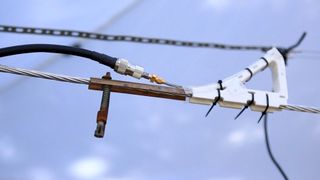Is Project AirGig the solution to all our broadband woes?
AT&T’s project uses existing power lines for super-quick Wi-Fi speeds
Why do we need AirGig?
The demand for fixed and wireless data is going ballistic, with AT&T reporting that data on its network has increased about 250,000% since 2007, almost all of which it attributes to the growth in video. However, there are still many people in the world – including in rural areas of the US – who suffer with slow internet connectivity, or indeed none whatsoever. AirGig might be a way of reaching them affordably.
However, fibre optic networks are the gold standard for broadband, and for many of us, the future of the internet. It's how continents are connected up using undersea cables. So why don't we just cover the world in fibre optics and ignore AirGig?
Technically, that is the answer to the problem (download speeds of 940Mbps are possible), but financially it's a non-starter. Such is the cost of installing physical cables, amplifiers and repeaters to every individual home and property that only a mere 23% of the US have access to it.
It's really only possible to install such networks in dense metropolitan areas, and that's not going to change drastically anytime soon. On the other hand, AirGig would be much easier and cheaper to deploy.

When will it happen?
BPL has been tested at AT&T's outdoor facility for a few years, but the company announced in February that it was in advanced discussions with power companies to trial Project AirGig in at least two locations before the end of 2017 – confirming that although one location will be in the US, the other won't be. This suggests that far from being a technology just for reaching remote rural communities of the US, AirGig could become a network technology used worldwide.
“We are looking forward to begin testing the possibilities of AT&T Labs’ invention for customers and utility companies,” says Fuetsch. There's a clue in his language – to make Project AirGig a reality means convincing myriad power companies who own the power lines to allow AT&T to use them.
Cue a campaign to convince them that AirGig could also help create smart grids. For instance, the AirGig radios could be installed with sensors that will alert the power companies if tree branches are getting close to the power lines.
Are you a pro? Subscribe to our newsletter
Sign up to the TechRadar Pro newsletter to get all the top news, opinion, features and guidance your business needs to succeed!

Could AirGig help create a 5G network?
The gigabit-per-second speed promised by AirGig is impressive, though not quite on a par with the technically possible 10Gbps plus speeds mooted by some in the telecoms industry.
In fact, some telecoms operators claim to have already achieved speeds up to 20Gbps in lab trials, with less than 1 millisecond of latency (the time between pressing play and seeing a video start to stream). So AirGig should probably be thought of as a stepping stone technology.
“AT&T is focused on delivering a gigabit-per-second speed everywhere we can with our wired and wireless technologies," said Fuetsch, hinting at a tech-neutral approach, but he has high hopes for AirGig. “We believe future 5G services will be one of the potential uses for Project AirGig.”

A transformative technology?
There's obviously some haste to create 5G-like speeds – or at least something that can be sold to people as 5G – as soon as possible, despite 2020 being the year mooted at MWC 2017 for the commencement of 5G networks.
“We’re not waiting until the final standards are set to lay the foundation for our evolution to 5G. We’re executing now,” said AT&T's John Donovan, chief strategy officer and group president, Technology and Operations, at CES 2017. “Project AirGig has tremendous potential to transform internet access globally – well beyond our current broadband footprint and not just in the US.”
However, he also confirmed that, for now, Project AirGig is still very much in the experimentation phase. Either way, it's potentially an ingenious way of using legacy equipment to make near-global broadband a reality.
Jamie is a freelance tech, travel and space journalist based in the UK. He’s been writing regularly for Techradar since it was launched in 2008 and also writes regularly for Forbes, The Telegraph, the South China Morning Post, Sky & Telescope and the Sky At Night magazine as well as other Future titles T3, Digital Camera World, All About Space and Space.com. He also edits two of his own websites, TravGear.com and WhenIsTheNextEclipse.com that reflect his obsession with travel gear and solar eclipse travel. He is the author of A Stargazing Program For Beginners (Springer, 2015),











